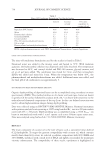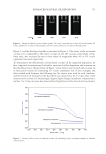743 INFLUENCE OF ETHNICITY AND DAMAGE LEVELS HAIR DAMAGE ASSESSMENT Fourier-transform infrared spectroscopy (ATR–FTIR). One hair tress from each damage group was analyzed using an infrared spectrometer with Fourier-transform, using the accessory for attenuated total reflectance (ATR, Cary 630, Agilent Technologies, USA). For each analysis, 64 scans were performed with a resolution of 4 cm−1, ranging from 4,000 to 400 cm−1. Protein loss quantification. Hair fibers from each damage group were cut (0.5 to 1.0 cm long), 250 mg of this cut hair was placed in plastic tubes with a conical bottom, and 4 mL of deionized water was added to it. The samples were incubated at 45°C for 72 h and centrifuged twice a day at 1,500 rpm for 1 min. The quantification of the total amount proteins in the supernatant was performed using the BCA1 Kit (Bicinchoninic Acid Protein Assay Kit, Sigma-Aldrich, USA) following the manufacturer’s instructions. The samples were analyzed using a UV–Vis spectrometer (Lambda 25, Perkin Elmer, USA) at 562 nm. Tensile Test. Forty-five fibers from each group were separated, prepared for analysis, and subjected to diameter measurement on the automated platform FDAS770 (Fiber Dimensional Analysis System, Dia-Stron, UK), which is coupled with a laser scan micrometer (LSM-6200, Mitutoyo, JPN). The tensile test was performed on a MTT680 (Miniature Tensile Tester, Dia-Stron, UK) using a constant stretch rate of 15 mm/min under controlled environmental conditions (22 ± 2°C and 50 ± 5% RH). Swelling test. Thirty fibers from each group were separated, prepared for analysis, and subjected to a swelling test on the FDAS770 automated platform (Fiber Dimensional Analysis System, Dia-Stron, UK) with a DSM770 (Dynamic Swelling Module, Dia-Stron, UK) accessory. The diameters of the fibers were measured in the rotational mode for 200 s using a laser micrometer (LSM-6200, Mitutoyo, JPN) coupled to the FDAS770 platform, while the fibers were submerged in water. Scanning electron microscopy (SEM). Three fibers from each group were separated and prepared for analysis by fixing 1 cm fragments with carbon tape. The samples were Au/ Pd (80:20) coated by sputtering in a Bal-Tec MD020 instrument (Balzers, Liechtenstadt). The images were acquired using a Quanta FEG 250 (FEI, Thermo Fischer Scientific, USA) operating at 5 kV. FRAGRANCE SUBSTANTIVITY TEST Fragrance raw materials. Five FRMs with different physicochemical characteristics were selected (Table I). Shampoo formulation. A mixture of the five FRMs at the same concentration (20% w/w) was prepared and applied at 0.5% (w/w) to a shampoo formulation (Table II). Table I Tested Fragrance Raw Materials Fragrance raw material Molecular weight (g/mol) Polarity (log P) Sulfurol 143.2 1.11 Geranyl acetate 196.3 4.48 Isoeugenol 164.2 2.65 Gamma Undecalactone 184.3 3.06 Tonalide 258.4 5.80
744 JOURNAL OF COSMETIC SCIENCE Internal standard. Ethoxybenzene (0.1 mg/mL in dichloromethane) was used as an internal standard for the quantification of the FRMs. Sample preparation. Six tresses (0.5 g/20 cm long) from each group were washed for 1 min with the shampoo formulation containing the FRMs (50 mg/0.5 g of hair) and rinsed under tap water (30 ± 3°C) for 30 s. Three of these tresses (T0 samples) were immediately placed in 10 mL glass flasks with lids containing 2 mL of dichloromethane. The other three tresses (T24 h sample) were subjected to the same process after drying under controlled conditions (22 ± 2°C and 50 ± 5% RH) for 24 hours. After 24 hours of extraction, the hair was removed from the flasks, and 100 μL of the internal standard solution was added to each flask. The samples were manually homogenized, dried with anhydrous sodium sulfate (Nuclear, CAQ, BRL) and filtered through a 0.2 μm PTFE filter (ValuPrep™ 25 mm, PALL Life Sciences, USA) to 3 mL chromatography vials. Response factor. Six tresses (0.5 g/17–20 cm long) from each group were washed with the shampoo formulation without the FRMs (50 mg/0.5 g hair) for 1 min and rinsed under tap water (30 ± 3°C) for 30 s. Each tress was placed in a 10 mL glass flask with a lid, with 2 mL of dichloromethane, and 100 μL of a solution of the five raw materials in dichloromethane at 0.1 mg/mL each. This procedure was performed immediately after washing (T0 samples) or after drying under controlled conditions (22 ± 2°C and 50 ± 5% RH) for 24 hours (T24 h samples). After 24 hours of extraction, the hair was removed from the flasks, and 100 μL of the internal standard solution was added to each flask. The samples were manually homogenized, dried with anhydrous sodium sulfate (Nuclear, CAQ, BRL), and filtered through a 0.2 μm PTFE filter (ValuPrep™ 25 mm, PALL Life Sciences, USA) to 3 mL chromatography vials. GC-MS analysis. The samples were injected in a gas chromatograph (6890N, Agilent Technologies, USA) with an automatic injector (Multi-Purpose Sampler 2, Gerstel, USA) coupled to a mass detector (Mass Selective Detector 5973, MSD 5973 Agilent Technologies, USA). A ZB-1MS column (60 m × 0.25 μm × 250 μm) was used for component separation. The injection mode was set to the splitless mode. The oven temperature program was adjusted to heat up to 50°C, hold for 8 min at this temperature, and then heat up to 240°C. The samples were analyzed in the selected ion monitoring mode after choosing three appropriate mass/load ratios for each raw material at the time of the assembly of the method in the equipment software (ChemStation, Agilent Technologies, USA). Table II Shampoo Formulation Component (INCI name) Concentration (%) Water q.s.100.00 Disodium EDTA 0.05 Polyquaternium-10 0.20 Glycerin 1.00 Sodium Laureth Sulfate 29.63 Cocamidopropyl Betain 8.00 1,2-Hexanediol, Caprylyl Glycol 0.80 Trideceth-9, PEG-5 Isononanoate, Water 1.00 PEG-150 Distearate 0.50 Cocamide DEA 1.50 Citric Acid q.s. pH 5.5–6.5 Sodium Chloride 0.15
Purchased for the exclusive use of nofirst nolast (unknown) From: SCC Media Library & Resource Center (library.scconline.org)






































































































































